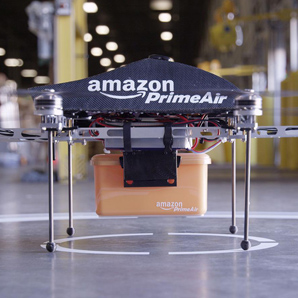Amazon Prime Air
This week Amazon.com announced that it's working on technology that will make deliveries by drone aircraft (hexacopters) straight to the customer's home.
At first it seems unbelievable that we're close to this sort of innovation being in widespread use but Amazon's boss, Jeff Bezos plans to have the system in place by 2015. Is this feasible?
Well I'm lucky enough to work very closely with RC Geeks who sell similar drone aircraft for enthusiasts (quadcopters) and have seen them in use many times first hand.
So what are the problems, technical and otherwise that Amazon will face?
Computer Control and Navigation
For the system to be worthwhile, the drones Amazon use will have to be totally autonomous. If each one needed a pilot to control it, the amount of man-hours needed would make the method too expensive. So they must fly totally autonomously. While this sounds like a tall order, the Phantom quadcopters that RC Geeks sell (currently for just £349) all have GPS and will return to where they took off if the controller is turned off or signal is lost. The accuracy is to within about 2.5 metres which is enough to land in a small garden. However sensors would be needed to avoid collisions with trees, power lines and fences. Although not included on the phantom, this would be cheap and easy for Amazon to add. They would need the customer to give a very precise location for the drone to land though - perhaps they'll be able to take coordinates from the customer's phone when placed in the garden or landing area. Navigating from the depot to the waypoint is already a solved problem but landing in a small space with things like washing lines/trees could prove tricky. Perhaps dropping the item with a parachute would work better.
Difficulty: Easy
Drone Aircraft Range
This may be one of the biggest obstacles for Amazon. It's likely that the signal will be sent on 2.4GHz or 5GHz which both offer a pretty good range of several miles. Because their transmitters will probably be based at the depot, they will be able to boost the signal with this and probably ranges of 10-20 miles wouldn't be a problem. It might be that the computer that controls the flight is on-board but it's likely a signal will still be needed to recall the drone to base if needed or to recover the drone in case it comes down and needs locating. The batteries on the other hand are a different story. RC Geeks sell a quadcopter which includes a gimble and camera (the Phantom Vision) which probably weigh a similar amount to a book. Flight time is around 25 minutes meaning that the range would effectively be limited to anywhere within a 10 minute radius if we take off 5 minutes to account for take-off, landing and a small safety buffer, and 10 minutes to return to base. Assuming a top speed of 30mph this gives a range of just 5 miles. It's possible that there could be a relay system where multiple drones pick up the package along its route or charging stations but both methods would slow the delivery down. Whether 5 miles is enough to make it worthwhile for Amazon is unclear but what is certain is that the amount of charge the batteries can hold and the range of the aircraft is increasing very rapidly. It's probably reasonable to assume that aircraft range doubles every 18 months in accordance with Moore's Law which originally predicted computer processor performance but has been found to apply to many other technical fields.
Difficulty: Medium but range will certainly improve
Safety Concerns and Law
As amazing as this technology is, there are always likely to be those who oppose it. Concerns would include the drones crashing in to people and property, wildlife, vehicles and even aeroplanes. I'd expect those events to be pretty rare but liable to happen occasionally. The drones are unlikely to fly anywhere near high enough to interfere with actual aircraft but there are likely to be very strict regulations about how close they can fly to airports. Near the depots I'd expect the buzz from the drones to be pretty loud, sounding like a giant nest of angry wasps and they may be required to reach a certain height before being allowed to move horizontally to their destination. There are also serious privacy concerns as it's likely the drones will have cameras mounted as these are small, lightweight and relatively cheap and the drones are likely to fly quite low over a lot of houses before reaching their destination. The rules governing these will vary from country to country. Some US states have banned these types of aircraft already for private use. All things considered, the legal obstacles may be the hardest to overcome.
Difficulty: Hard but it's inevitable that this sort of technology will be accepted eventually
blog comments powered by Disqus


















